Wysall Conservation Area
Wysall Conservation Area Appraisal and Management Plan February 2024
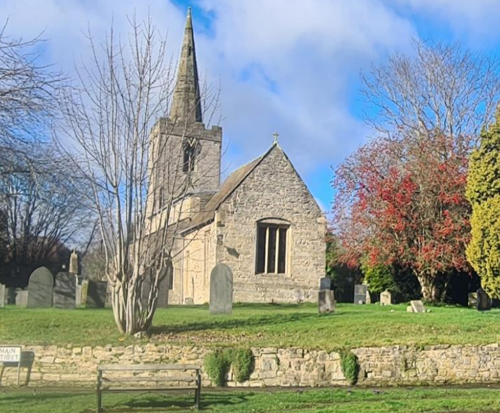
Contents
1.1 Conservation Areas
1.2 The Purpose of a Conservation Area Character Appraisal
1.3 The Planning Policy Context
2 Wysall Location and Landscape Setting
2.1 The Wysall Conservation Area
3.1 Location and Historic Activities
3.2 Archaeology
3.3 Historical Mapping
4.1 Plan, Form and Layout
4.2 Landmarks, Focal Points and Views
4.3 Open Spaces, Trees and Landscape
4.3.1 Open Spaces, Trees and Landscape SWOT Analysis
4.4 Public Realm
5 Buildings of the Conservation Area and Key Characteristics
5.1 Building Types and Activity
5.1.1 Building types and Activity SWOT Analysis
5.2 Key Characteristics and Building Materials
5.2.1 Key Characteristics: Historic Core - Zone 1
5.2.2 Key Characteristics: Keyworth Road - Zone 2
5.2.3 Key Characteristics: Entrance to the village from the south - Zone 3
5.2.4 Key Characteristics: SWOT Analysis
5.3 Listed buildings
5.4 Key Unlisted Buildings
6.1 Introduction
6.2 National and Local Policies and Guidance
6.3 Article 4 Directions
6.4 Building Design
6.5 Publicity and Knowledge Transfer
6.6 Public Realm
6.7 Boundary Treatments
6.7.1 Walls and Fences
6.7.2 Hedges
6.8 Buildings at risk
6.9 Enforcement
7 Appendix 1 – Listed Buildings (as of date)
8 Appendix 2 – Conservation Area Boundary and Townscape Appraisal Map
1 Introduction
1.1 Conservation Areas
Rushcliffe Borough Council has an obligation under Section 69 of the Planning (Listed Buildings and Conservation Areas) Act 1990 to review, from time to time, its Conservation Area designations.
A Conservation Area, as defined under Section 69, is ‘an area of special architectural or historic interest the character or appearance of which it is desirable to preserve or enhance’.
Wysall Conservation Area was designated in 1990. Prior to this reappraisal of 2024, the Wysall Conservation Area was reviewed in 2010.
Section 71 of the Planning (Listed Buildings and Conservation Areas) Act 1990 highlights the local planning authority’s duty to formulate and publish proposals for the preservation and enhancement of the conservation areas. This document, therefore, aims to identify and
reaffirm (or redefine) the special architectural or historic interest of the area which warrants its designation.
Conservation Area Appraisals are not, and never have been, tools for to fossilise a place against change, instead, the processes of change which allow places to grow and evolve are recognised as being unavoidable, and it is also recognised that change can be a positive and desirable force. The designation instead allows greater scrutiny and control to manage change to positive effect and to ensure that any changes which require planning permission do not harm, and ideally serve to actively enhance, the existing character of the place.
Wysall Conservation Area: Summary of Special Interest
A typical Nottinghamshire village with an informally arranged collection of mostly 18th and 19th century traditional buildings and later infill development.
The churchyard of the medieval Holy Trinity Church is the village’s principal focal point.
Tree lined Main Street runs north south and forms the principal thoroughfare.
On the fringes of the village views over open countryside combine with grass verges and hedgerows to provide attractive rural approaches.
1.2 The Purpose of a Conservation Area Character Appraisal
The purpose of a Conservation Area Character Appraisal is to:
- Identify and record the special interest of the Conservation Area to ensure there is public awareness and understanding of what is
worthy of preservation. - To define and reassess current boundaries to accurately reflect what is now perceived to be of special interest.
- To identify opportunities to safeguard and enhance the special interest of the Conservation Area.
It should be noted that the content in this document is not a comprehensive account of every significant building, structure, tree, wall, feature, or space. Therefore, any omission should not be assumed to imply that they are of no interest.
Generally, the character and appearance of a Conservation Area will be preserved or enhanced by:
- Providing controls and regulating development through the planning system.
- Applying the extra controls that designation provides over demolition, minor development, and the protection of trees.
- Environmental enhancement schemes and possibly providing financial assistance for the repair and restoration of specific buildings.
- Encouraging public bodies such as the local highways authority or utility companies to take opportunities to improve the street scene through the appropriate design and sensitive sighting of street furniture (and retention of historic features of interest), or the removal of eyesores and street features that have a negative impact such as overhead wires.
Wysall Conservation Area: Summary of Key Issues
Community facilities – lack of shop, threat of closure to the Public House.
Boundary treatments – prominent brick wall on west side of Main Street is threatened through disrepair.
Development – New houses on Widmerpool Road are felt by many residents to be unsympathetic to the character of the village. Further three storey development would harm the readability and understanding of Wysall’s historic character. Traditionally only the key high-status buildings were three storeys tall.
Highways and transportation – speeding cars and lorries passing through the village, cars parked on Keyworth Road create a safety hazard, noise from low flying aircraft.
Public realm – Proliferation of street signs.
1.3 The Planning Policy Context
This appraisal provides a firm basis on which applications for development within the Wysall Conservation Area would be
assessed. It should be read alongside the wider development plan policy framework produced by Rushcliffe Borough Council and other
National Planning Policy Guidance documents. The relevant documents include:
- Rushcliffe Local Plan Part 1: Core Strategy, with a specific focus on:
- Policy 10 (Design and Enhancing Local Identity) [in part]
- Policy 11 (Historic Environment)
- Rushcliffe Local Plan Part 2: Development Policies, with a specific focus on:
- Policy 28 (Conserving and Enhancing Heritage Assets)
- Policy 29 (Development Affecting Archaeological Sites)
- The National Planning Policy Framework (NPPF) (Revised -2023)
- The National Planning Practice Guidance (2015 - Subject to Continual Review)
- By Design: Urban Design in the Planning System – Towards Better Practice (2000)
- The Planning (Listed Buildings and Conservation Areas) Act 1990
2 Wysall Location and Landscape Setting
Rushcliffe Borough forms the southern tip of Nottinghamshire, which borders Leicestershire. It is predominantly a rural Borough that contains a mixture of city suburbs, market towns and villages. Rushcliffe is located about half a mile South of Nottingham city centre, with the River Trent forming the majority of its northern boundary and the River Soar defining its western boundary.
The A46, a distinctive Roman Road, runs through the centre of the Borough and leads to Newark in the North and Leicester in the South. In the northern half of the Borough, the A52 forms Nottingham’s primary transport link to Grantham and the East of England. Junction 24 of the M1 and East Midlands Airport are located about 1 mile from the western border.
Wysall is a charming village nestled in the countryside and linked with its neighbouring village of Thorpe, both of which are run by the parish council. Wysall is situated on the edge of the Wolds about 9 miles southeast of Nottingham. It is approximately 3 miles to the west of the Fosse Way in the gently undulating valley of the Kingston Brook, which winds its ways past the village to the south. The village is neighboured by the large village of Keyworth to the north, Widmerpool to the east, Willoughby on the Wolds to the southeast,
Wymeswold to the south and Costock to the southwest.
The surrounding countryside consists primarily of large arable fields lined with hedgerows.
2.1 The Wysall Conservation Area
This small 9-hectare Conservation Area includes all of the built-up area of the village, which contains 5 Listed Buildings or structures, including the Church of Holy Trinity, Manor Farmhouse, The Nook, Rectory Farmhouse and Manor House Farmhouse. The Conservation Area was designated in 1990.
Wysall’s appeal lies in the interplay between its informally arranged historic buildings, varied traditional boundary treatments, attractive grass verges, and groups of mature trees. The subtle curves in the village’s linear plan form reveal a pleasing sequence of views from the rural northern approach, through the tree shaded Main Street and on to the picturesque churchyard of Holy Trinity in the south.
- Conservation Area Boundary covers: 9 hectares (approximate)
- Number of Grade I listed buildings: 1
- Number of Grade II* listed buildings: 0
- Number of Grade II listed buildings: 4
A full list of Wysall Conservation Area’s Listed buildings can be found in Appendix 1.
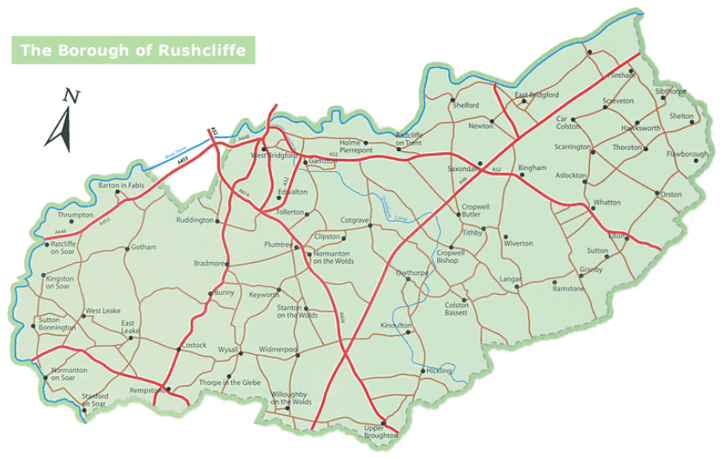
3 Historical Contexts
3.1 Location and Historic Activities
Throughout history Wysall has been recorded as several variations to its contemporary name, including Wisoc, Wisho, Wisou, and others. According to Thoroton, its name likely signifies 'a Hill of Plants or a Custom Hill', although Ekwall suggests the Old English forms hoh, meaning 'spur of hill', and weoh, meaning 'of a heathen temple'.
Prior to the Norman Conquest, the village's land ownership primarily consisted of three portions held by Æstan, Alsige, and Glædwin. The presence of a church in Wysall was also documented to predate 1066, a period when England was nominally Christianised, with paganism banned by the church. It's likely that the original pre-Norman structure was a typical Anglo-Saxon 'wooden box' design, possibly located at the current site of the church.
The initial Anglo-Saxon construction was torn down and replaced with a Norman stone church, erected around the late 11th or 12th century. This newer building stood for only a couple of centuries, however, evidence of its existence can still be observed, notably through a Norman doorway embedded in the church's northern wall.
The building incorporates Norman stonework in the north wall and its 13th century tower and spire still dominate the skyline of the village. In the 15th century, they changed the roof using a new method (although we don't know exactly how), making it lower. This allowed them to add clerestory windows to brighten up the inside of the church. This mainly 14th century church of Holy Trinity is the oldest building in the village today.
Other notable buildings are the part Elizabethan timber framed Manor House which dates from the 16th and 17th century, and the red brick and pantile cottage on Widmerpool Road known as The Nook, the end gable wall of which is inscribed "1718" in blue bricks. There are a number of farmhouses which reflect the history of the village.
By 1894, Wysall was a lively hub served by a number of amenities including its very own school, as well as various craftsmen such as a wheelwright and blacksmith, a joiner, a bootmaker, and a grocer. Additionally, it boasted a butcher's shop and even a manufacturer of Stilton cheese. However, by 1985 the vast majority of these amenities had been lost and today the only one that remains is the Plough Inn Public House. This building was originally a pair of cottages which were joined together to form a hostelry in 1790. Today the majority of Wysall’s 300 or so inhabitants commute out of the village for work and school. The village did not share in the 19th century growth of the framework knitting industry which took hold in many neighbouring settlements and continued until the latter half of the 20th century as a largely selfcontained community devoted to agriculture.
The built form of the village remained characterised by farmhouses, worker’s cottages and agricultural buildings, many of which survive to this day.
3.2 Archaeology
There are no scheduled monuments in Wysall. There is a medieval to post medieval shrunken village in the field between Costock Road and Wymeswold Road.
Near the centre of the shrunken village, there's a well-kept field system with ridge and furrow formations and small enclosed fields. Along its western edge, potential building sites and a well are found. Linear banks and ditches indicate enclosure boundaries, possibly dividing crofts, with ridge and furrow patterns seen in aerial photos on the southern side of the village.
Building plots are also spotted near the churchyard and around the village's perimeter, which is surrounded by ridge and furrow formations, further hinting at a shrunken village site. Both glazed and unglazed scatters of pottery from the Medieval period have been found to the south, and across the river of the sunken village site. There was also a Roman fibula (broach) found on this site which is to the south of the sunken village. The Conservation Area boundary was extended in 2024 to include this site due to its historical interest.
3.3 Historical Mapping
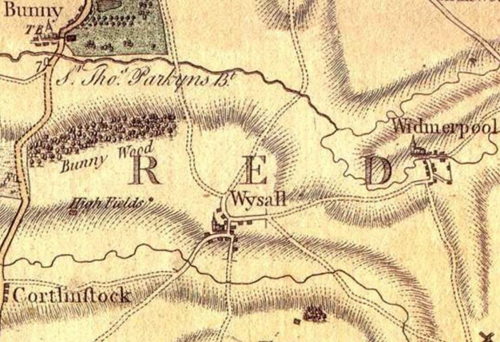
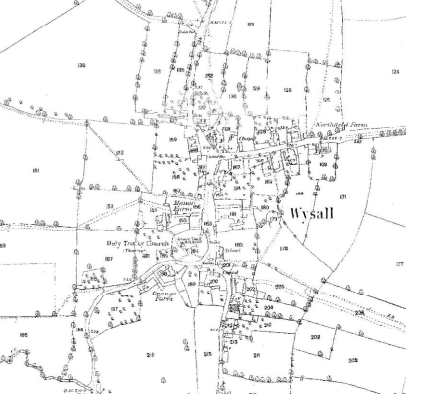
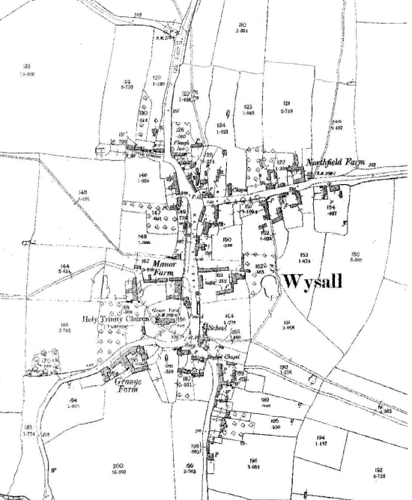
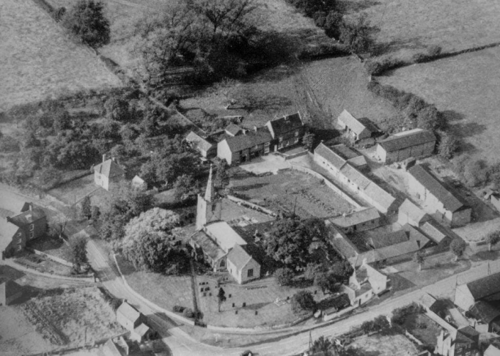
4 Spatial Analysis
The relationship between open spaces and the built form within a conservation area can be central to its character. This section describes the village’s layout, highlighting the significant views, landmarks and historical focal points. The contribution of open green spaces, trees and other natural elements to the conservation area’s character is also described within this section.
4.1 Plan, Form and Layout
Wysall’s historic street pattern consists of a linear central thoroughfare running north-south (Main Street, Keyworth Road and Wymeswold Road) and three smaller roads branching off to the northwest (Bradmore Road), east (Widmerpool Road) and southwest (Costock Road).
A number of small cul-de-sacs can also be found throughout the village where modern infill development has taken place. There is also a ribbon development, set back from the main road with a parallel access road which is screened with vegetation. While the ribbon development to the east is not included within the conservation area, the grass verge, hedgerow and trees (which contribute positively to the character of Keyworth Road), are within the boundary.
Most of the historic buildings in the village are concentrated around Main Street, Wymeswold road and Widmerpool Road. Traditional cottages and farmhouses tend to be either set back behind front gardens or wide grass verges or positioned close up against the edge of the highway. Barns and outbuildings are more sporadically arranged while the larger houses of Manor Farm and The Old Vicarage are situated in private grounds.
Below is a map that describes the current plan, form and layout of the village/town.

This map is reproduced from Ordnance Survey material with the permission of Ordnance Survey on behalf of the Controller of Her Majesty’s Stationary Office © Crown Copyright. Unauthorised reproduction infringes Crown Copyright and may lead to prosecution or civil proceedings. Rushcliffe Borough Council - 100019419
4.2 Landmarks, Focal Points and Views
Wysall’s most striking landmark and principal focal point is the 13th century church and churchyard of Holy Trinity in the south of the village. In the north of the village the junction of Main Street, Keyworth Road and Widmerpool Road forms a secondary focal point with its attractive arrangement of buildings and wide grass verges. The church tower features strongly in views along Costock Road and Wymeswold Road.
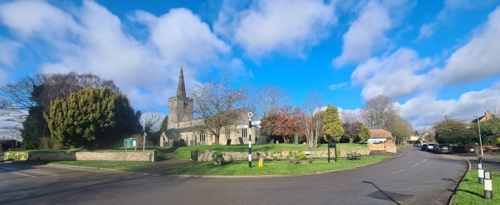
Also of note is a glimpse from Main Street of the picturesque 16th century Manor House which acts as a visual stop at the end of Manor House Drive.

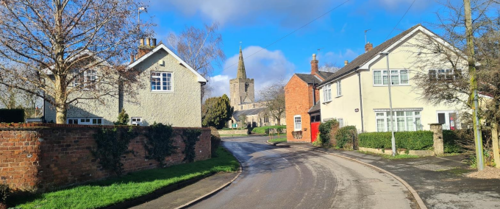
Views over surrounding countryside and pasture can be gained from many places on the edges of the built-up area.

4.3 Open Spaces, Trees and Landscape
Wysall is surrounded by an open landscape (see Figure 10) that is easily accessible by public footpaths, but within the village itself the churchyard is the only significant area of open green space (see Figure 6).
The wide grass verges found throughout Wysall help to soften the built-up area within the village (see Figure 11 and Figure 12) and create a distinctly rural feel on the approaches to the village where they are found in conjunction with hedgerows and mature trees.
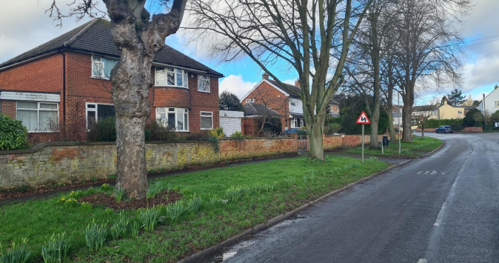
Over the years the local community in Wysall have planted a considerable number of daffodils throughout the village and are found adorning the grass verges. They have become emblematic of the village's natural environment, fostering community engagement and enjoyment, with residents and visitors alike gathering to admire them.
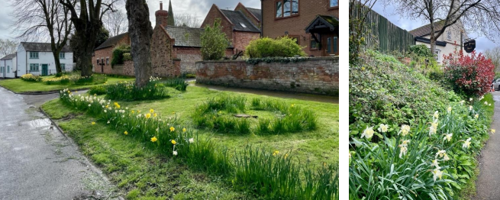
4.3.1 Open Spaces, Trees and Landscape SWOT Analysis
Strengths - what are the positives of the open spaces, trees, and landscape
- Occasional views out into attractive surrounding landscape, fields and pasture.
- Grass verges with daffodils planted by the local community, and mature trees softening the built environment.
Weaknesses - what are the negatives of the open spaces, trees, and landscape
- Proliferation of street signage.
Opportunities – what could make the open spaces, trees, and landscape better?
- None listed.
Threats - what would make open spaces, trees and landscapes worse?
- The loss of views out into the surrounding countryside.
- Any industrialisation or over-commercialisation of the surrounding countryside that would erode the beauty of the surrounding green landscape.
Works to Trees
You must contact the Local Planning Authority (LPA), Rushcliffe Borough Council before any works (cutting OR pruning) are carried out to trees within the Wysall Conservation Area.
Six weeks’ notice is required before any works to trees within the Conservation Area is carried out, even if they are not protected by a Tree Preservation Order (TPO).
You can use a Standard notification form (a section 211 notice), to inform us of the works you would like to undertake.
A flow chart of the decision-making process regarding works to trees.
4.4 Public Realm
The boundary treatments in the Conservation Area are extremely varied and include brick and stone boundary walls of various heights, beech, privet, yew and hawthorn hedges, timber picket fences, iron railings and metal fencing, grass verges and properties which front directly onto the highway.

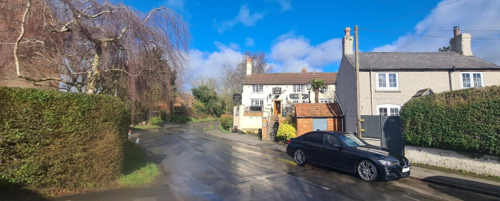

While the boundary treatments vary, the grass verges which are often in close proximity to the boundaries, act as a unifying feature throughout the Conservation Area.
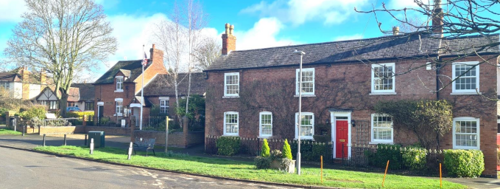

The roads in the village are paved with asphalt and flanked by grass verges and/or a narrow pavement (as can be seen in Figure 19). The properties leading up to the Manor along Manor house drive (as can be seen in Figure 20) do not have elevated boundary treatments. There is also no pavement, and the drive is a shared space for vehicles and pedestrians.
Elsewhere in the village, private drives and minor roads are sometimes surfaced with gravel which creates a more informal rural character.
The public realm also includes some attractive traditional street furniture such as the two cast iron finger signposts, the Thankful Bench and Sign (see Figure 21 to Figure 24). There is also a K6 Red Telephone Box on Mainstreet (see Figure 20), which is now used to house a defibrillator. The original design of the K6 Kiosk was commissioned to commemorate the Silver Jubilee of King George V. in 1935.
Wysall is a Thankful Village, (also known as a Blessed Village), as all 12 of their members of the armed forces returned to the settlement from World War I. There are consequently no memorials to commemorate lost soldiers, however there is a Thankful Village memorial (see Figure 22) and a commemorative bench in front of the village hall on the opposite side of the road (see Figure 24).
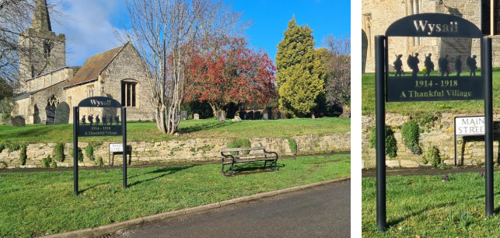
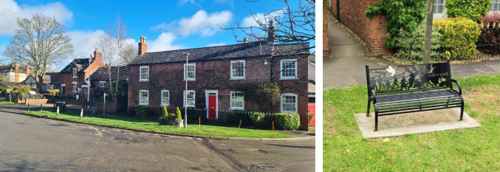
In 1920, a church clock was commissioned to honour the courage of 12 villagers who fought in WWI. The timepiece, crafted by G & F Cope and Co., came with a price tag of £118. Notably, the same skilled clockmakers were also responsible for designing the Council House clock in Nottingham city centre.
There are four thankful villages in Nottinghamshire and Wysall is the only one outside of the Newark and Sherwood District.
5 Buildings of the Conservation Area and Key Characteristics
5.1 Building Types and Activity
Wysall’s building stock exhibits a wide variety of architectural styles from different periods in its history.
Pre-1900s cottages and farmhouses can be found in a very wide variety of sizes, but they generally have an elongated plan form and are almost all two storeys in height.
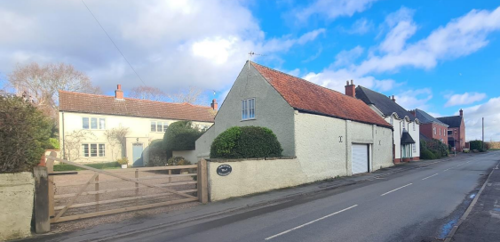
Other traditional building types include a number of barns and outbuildings acting as reminders of Wysall’s agricultural past, a Wesleyan Chapel (see Figure 26) and a Victorian schoolhouse, established in 1871 and then stopped functioning as a school a century later. The former school building now serves not only the local parish residents but also those from nearby villages in its current role as a public facility—the Village Hall (see Figure 26).

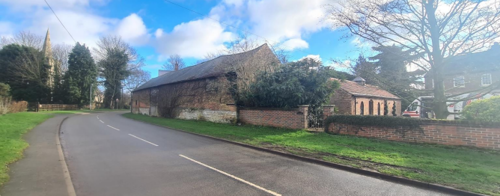
Much of the infill development in the village dates from the mid twentieth century. Buildings from this period are mostly detached bungalows or dormer bungalows set back behind front gardens. More recently built properties include semidetached and terraced houses of varying sizes, most of which are two storeys in height.

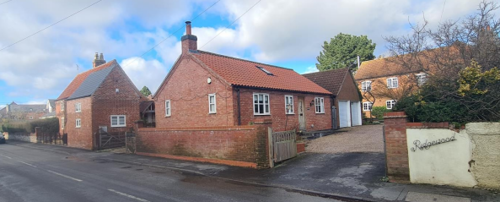
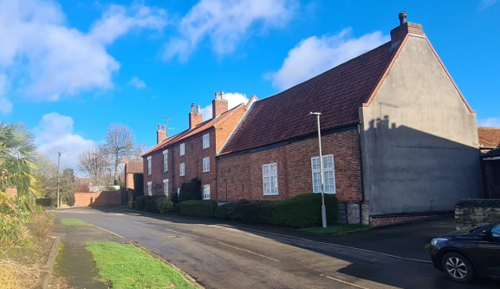
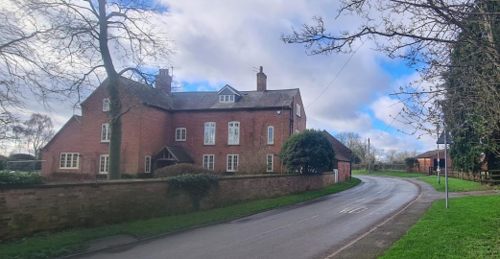
5.1.1 Building types and Activity SWOT Analysis
Strengths - what activities/places can you go that make the village/town great?
- Community spirit within the village which is reinforced by the Public House, the Church and other community activities.
- The 19th century public house, The Plough.
- The visual presence of the Church from various points around the village.
Weaknesses - what activities/places exist that detract from making the village/town great?
- The speed of the traffic travelling through the village along with the number of cars parked along Keyworth Road.
Absence of village shop.
Opportunities - what activities/places could exist that would village/town even better?
- Maintain Public House as community facility.
Threats - what activities/places would make village/town worse?
- Loss of the Public House as a community facility.
5.2 Key Characteristics and Building Materials
Traditional building materials were largely locally sourced. Bricks for example, were not transported far from where they were made, with most villages having their own brick pit and yard. This led to interesting village-specific sizes, colours and styles of brickwork. Roofs would have been made from local materials such as thatch until clay pantiles became popular.
5.2.1 Key Characteristics: Historic Core - Zone 1
Traditional Materials:
Walls: Walls are predominantly of orange/red brick, but detailing varies considerably. Brick is sometimes used in conjunction with earlier sections of coursed rubble stone or ashlar finishings. Wysall also has a significant proportion of buildings which are painted white or rendered and painted.
Roofs: The roofs are predominantly clay pantiles (particularly in the case of former farm outbuildings) and Welsh slate with a small number of plain-tile roofs. Thatched roofs would once have been common and although thatch has long since been replaced with other materials, some buildings still retain the steeply pitched roofs which would have been needed to ensure adequate water run-off. Chimneys are generally simply designed and positioned on the roof ridge or built into the gable walls. Rainwater goods are traditionally of cast iron.
Windows: Windows that have not been replaced with uPVC can be characterised by their painted timber casements with many creating symmetrical façade and having glazing bars. Arched brick lintels are most prominent, but some examples of ashlar lintels also exist.
Doors: Traditional doors within the Conservation Area are a mixture of timber four and six panelled, plank and batten and part glazed examples.
Key Characteristics / Architectural Features:
This area is characterised by the informally arranged historic cottages, farmhouses, barns and outbuildings intermingled with later 20th century infill development with a more regimented layout.
Flemish bond and stretcher bond brickwork are the most commonly found but there are also rare examples of English Bond. Detailing is restricted to occasional dentil courses, string courses and blue brick courses but the vast majority of traditional buildings are relatively restrained in their use of such features.
Windows are mainly timber casement, however there are a few examples of other window types including Yorkshire sliding sashes, Georgian style sashes, stone mullioned casements, leaded glass and gothic tracery.
Glazed over-lights are a common feature and are often seen in conjunction with classical style timber canopies. Timber framed or brick porches are also found throughout the village.
Grass verges help to soften built up area and churchyard provides the village’s key focal point.
5.2.2 Key Characteristics: Keyworth Road - Zone 2
Materials:
Walls: Walls within this character area are all brick, however some are painted white, and others are rendered with a light muted tone finish.
Roofs: Roofs are generally clay tiled, some with dormer windows.
Key Characteristics / Architectural Features:
Upon approach to the village, most noticeable within this character area are the grass verges, with hedgerows and trees.
Along a parallel driveway behind the hedgerow and trees is a 20th Century ribbon development, consisting of large, detached properties set along a parallel driveway.
5.2.3 Key Characteristics: Entrances to the village from the south - Zone 3
Key Characteristics / Architectural Features:
Arable fields bordered by hedgerows. Standing in private grounds to the northwest of the village is The Old Vicarage, an imposing Victorian property.
5.2.4 Key Characteristics: SWOT Analysis
Strengths - what is it about the character of the area that looks good?
- Existing historic buildings
- Low building density and spacious character
- Landmark three storey buildings
- Traditional front doors and canopies on historic buildings
Weaknesses - what is it about most existing buildings / character of the area that does not look good?
- Unsympathetic recent development
- Proliferation of street signage
- Poor condition of prominent brick boundary wall on west side of Main Street
Opportunities - what could make existing buildings (or new builds) look good and contribute to the character of the area?
None listed.
Threats - what could make existing buildings (or new builds) look worse and detract from the character of the area?
- Further three storey development
- Further disrepair to the boundary wall on west side of Main Street
5.3 Listed buildings
Buildings on the Government’s List of Buildings of Special Architectural or Historic Interest are called “Listed” buildings and are protected by law. Consent is required from Rushcliffe Borough Council before any works of alteration, extension, or demolition can be carried out on any listed building.
Further information can be found in Rushcliffe Borough Council’s publication Listed Buildings in Rushcliffe.
The complete list of the Secretary of State’s Statutory List of Buildings of Special Architectural Interest or Historic Interest.
Names of the Listed Buildings and structures in Wysall Conservation Area (correct as of [DATE]) are detailed in Appendix 1. All Listed Buildings are shown on the Townscape Appraisal plan, but some smaller structures such as gravestones may not be shown.
5.4 Key Unlisted Buildings
Contribution to the established character of the place can also come from buildings which are not recognised via listing or are not old. A plan with all of the positive contributions to the area can be found in Appendix 2 - Conservation Area Boundary and Townscape Appraisal Map.
Images of many of the Key Unlisted Buildings have been used throughout the appraisal.
6 Generic Management Plan for Conservation Areas in Rushcliffe
6.1 Introduction
In carrying out its planning functions, the Borough Council is required in law to give special attention to the desirability of preserving or enhancing the character or appearance of Conservation Areas. The Management Plan for a Conservation Area is a tool to ensure the special character of the area is preserved and enhanced. The management plans aim to:
- Outline a strategic management proposal for the preservation and enhancement of the Wysall Conservation Area.
- Act as a guide for professionals and residents alike regarding:
- features of value, worthy of preservation;
- characteristics worthy of preservation;
- opportunities for enhancement;
- development proposals which preserve and enhance the special character of the area.
- Inspire community commitment to conservation principles and reporting.
6.2 National and Local Policies and Guidance
There is a duty to formulate and publish management plans setting out policies and proposals for the preservation and enhancement of Conservation Areas. Many of these policies and proposals are common to all Conservation Areas, and these are set out in this document. The Central Government Guidance and Local policies applicable to Conservation Areas include:
- Rushcliffe Local Plan Part 1: Core Strategy, with a specific focus on:
- Design and Enhancing Local Identity [in part]
- Historic Environment
- Rushcliffe Local Plan Part 2: Development Policies, with a specific focus on:
- Conserving and Enhancing Heritage Assets
- Development Affecting Archaeological Sites
- The National Planning Policy Framework (NPPF), particularly, but not exclusively the chapter on Conserving and Enhancing the Historic Environment.
- The National Planning Practice Guidance (NPPG) (updated 2021 and subject to continual review)
- By Design: Urban Design in the Planning System – Towards Better Practice (2000)
- The Planning (Listed Buildings and Conservation Areas) Act 1990
- Historic England “Historic England Advice Note 1: Conservation Area Designation, Appraisal and Management”
The council will utilise the full range of strategic policy and guidance documents to ensure that development in Wysall Conservation Area is of a standard that enhances the amenity of the local area. The council will always look to use the most up-to-date versions of the document.
Supplementary documents may be issued for individual Conservation Areas where specific policies or proposals are needed.
6.3 Article 4 Directions
There are extra consents required in Conservations Areas. For example, in addition to the general control of development, you will
need to get permission for
- Any additions or alterations to the roof (for example, dormer windows)
- The installation of satellite dishes on chimneys, roofs or walls fronting a highway
- Any extension which extends beyond the side of the original dwelling house
- Any extension of more than one storey that extends beyond the rear wall of the original dwelling house
- Cladding the exterior of the dwelling
- Any demolishing of a building or part of a building that has a volume over 115 cubic metres
Article 4 of the Town and Country Planning (General Permitted Development) Order 1995, allows planning authorities to restrict
some permitted development rights within particular areas. This does not necessarily prevent development or change taking place
but enables the Local Authority to manage the design and detailing of the works, and potentially grant permission subject to appropriate conditions. The use of Article 4 Directions will be proposed where it is considered appropriate following the completion of each Area Appraisal across the Borough.
Details of Article 4 Directions for Wysall Conservation Area
There are currently no Article 4 Directions for Wysall Conservation Area.
6.4 Building Design
Mimicking the local vernacular is not the only way to ‘fit in’ with the character of a conservation area. National policy makes clear that contemporary designed, provided it is sympathetically designed, cannot be dismissed as an option. Therefore, good contemporary design will be encouraged where it respects the context’s character, scale and massing. This must be demonstrated in the Design and Access Statement submitted with any planning application.
Extensions to buildings in Conservation Areas should respect:
- The key characteristics of the original building, including scale, mass, materials and proportions
- The contextual setting and character of the Conservation Area
Copying like for like can devalue and destroy the ability to “read” historic change, and dilutes our historic heritage. Pastiche designs, incorporating poor imitations of other styles, will be resisted, particularly where they incorporate details which are not locally appropriate. Careful high-quality replication may be required in a few very sensitive locations.
In particularly sensitive locations, such as uniform terraces, exact replication may be necessary to maintain compositional unity. In that case, attention to details, choice of materials and high-quality workmanship are the keynotes. However, in some cases, a direct relationship is not impossible. For example, Flemish Bond brickwork cannot be replicated in cavity walls, and narrow lime mortar joints cannot be replicated in modern metric brickwork.
Where a new building is appropriate, on infill sites or where an existing building detracts from the character of the area, the opportunity should be taken to re-establish the streetscape, reinforce enclosure, open up distant vistas or views of landmarks or hide unsightly views.
“New and old buildings can coexist happily without disguising one as the other, if the design of the new is a response to urban design objectives” (DETR – “By Design”, p19).
As with extensions, good contemporary design which respects local character, and the context of the site will be encouraged.
All new buildings should respond appropriately to the existing frontage and normally follow the established building line. Development or redevelopment will normally be resisted if:
“it blocks important views identified in the individual appraisals, uses important open spaces identified in the appraisals, adversely affects the setting of any Listed or key buildings, fails to maintain or re-establish the streetscape where appropriate dominates its Conservation Area background fails to recognise the context of
the site destroys important features identified in the individual appraisals such as boundary walls, fences,
hedgerows or trees”
Where the quantity of contemporary schemes in a small area becomes significant and outnumbers older buildings within the area, further contemporary schemes could fundamentally shift the architectural character of the area and thus be harmful, even if well designed as an individual project.
New development that stands out from the background of buildings may be appropriate in exceptional circumstances if it contributes positively as a landmark to enhance the street scene, to highlight a corner or to signal a visual change of direction such as along a curving vista.
Any external lighting should be carefully designed and sited to minimise light pollution.
Energy producing or saving devices are generally welcomed by the Council, but careful consideration is required when these are to be located in a Conservation Area and some may require planning permission. In particular, they should be positioned to minimise their impact on the building and on the local amenity.
6.5 Publicity and Knowledge Transfer
Ambiguity about additional controls within a Conservation Area raises the likelihood of inappropriate developments occurring which
may damage the integrity of the conservation area designations.
Efforts have been made to engage local community groups in the development and review of the character appraisals. Empowering
communities to define the special architectural and historic interest of the Conservation Area aims to raise awareness.
Whether the appraisal took a community-led or a council-led approach, upon reviewing all Conservation Areas, the public were invited to ask questions and comment during a public consultation.
A consultation event also aimed to diminish any ambiguity about restrictions within a Conservation Area and increase the likelihood of sensitive and appropriate developments, maintaining the character of the area.
The council recognise the potential issues of turnover in residency and ownership of properties in the conservation area. Therefore,
Rushcliffe Borough Council will periodically use their media outlets to highlight conservation area designations and the significant,
related planning controls.
The approach taken within Wysall Conservation Area was a [Community Led / Council Led]
The consultation period took place between the following dates [DD/MM/YYYY and DD/MM/YYYY]
The date of the Consultation Event [DD/MM/YYYY]
If there are any queries about conservation areas, please email conservationareas@rushcliffe.gov.uk
6.6 Public Realm
General maintenance and upkeep to the public realm may include fixing damage to roads and pavements, and fixing issues with street lighting. Issues such as these can impact the quality of the Conservation Area.
The council aims to encourage works to the public realm that are in keeping with, or actively enhance the conservation area. Rushcliffe Borough Council can only advise on work within the public realm that does not require planning permission (for example work completed by statutory undertakers, such as the Highways Authority). In these instances, Rushcliffe borough council cannot prevent such work.
Nottinghamshire County Council are responsible for repairs to roads, pavements and street lighting. Report issues of repairs to roads, pavements and street lighting to Nottinghamshire County Council online.
Rushcliffe Borough Council will continue to undertake their duties in maintaining the public realm. Vandalism, fly tipping and street cleaning are all the responsibility of Rushcliffe Borough Council. Report issues to Rushcliffe Borough Council online.
Works to Trees
You must contact the Local Planning Authority (LPA), Rushcliffe Borough Council, before any works (cutting OR pruning) are carried out to trees within the Wysall Conservation Area
Six weeks’ notice is required before any works to trees within the Conservation Area is carried out, even if they are not protected by Tree Preservation Order (TPO).
You can use a Standard notification form (a section 211 notice) - to inform us of the works you would like to undertake.
A flow chart of the decision-making process regarding works to trees.
6.7 Boundary Treatments
Where there is a proposal for a new boundary treatment to be installed, the council would encourage the use of boundary treatments within the area.
Within conservation areas, planning permission is required to alter, maintain, improve, take down or build any new gate, fence, wall or other enclosure with:
- A height of one metre or more if next to a highway (including a public footpath or bridleway), waterway or open space; or
- A height of two metres or more elsewhere.
Where planning permission is required to remove a wall, Rushcliffe Borough Council will aim to protect those boundary walls and fences that have been identified as positively contributing to the area.
Hedgerows are significant habitats for wildlife in lowland Britain. Regulations are intended to protect important hedges in the countryside. The policy applies to hedges that are more than 20m long, (or less if connected to another hedge) on or adjacent to:
- Land used for agriculture or forestry, including the keeping of horses or donkeys
- Registered common land and village greens
- Local Nature Reserves and Sites of Special Scientific Interest.
The policy does not apply if the hedge is within or on the boundary of the curtilage of a house.
6.8 Buildings at risk
A few of the important buildings across the various Conservation Areas are currently vacant or not in regular use, which may lead to some being “at risk” of neglect or decay.
The Council will encourage and advise on renovation and repair work that is sensitive to the original or traditional historic character of the building and retains original features. The council will monitor the opportunity and potential for grant aid schemes to encourage the basic maintenance work necessary to ensure that key buildings within the conservation area are structurally sound and weather tight. However, given the current financial climate and outlook, such schemes are unlikely in the short to medium term.
There is a presumption against the demolition of buildings which contribute to the character of the area unless there are exceptional circumstances. It would benefit both the physical form and the function of the Conservation Area if these buildings were repaired, maintained and brought back into use.
Where the poor condition of a building or structure is as a result of neglect and lack of maintenance by its owner there is no requirement for the Borough Council to take its deteriorated condition into account when deciding whether demolition is appropriate. This is to avoid rewarding the deliberate neglect of buildings by representing such action as a way to obtain planning permission for demolition and redevelopment.
6.9 Enforcement
Rushcliffe Borough Council will, from time to time, assess and monitor changes in the appearance and condition of Wysall Conservation Area. This will ensure that where necessary enforcement action can be taken promptly to deal with problems as they arise.
Where co-operation cannot be gained by any other means, Rushcliffe Borough Council has the ability to use additional enforcement powers to tackle particular issues within conservation areas. The Council may take formal action if the condition of any building (listed or unlisted) which makes a positive contribution to the character of the Conservation Area is considered to be at risk.
The council will work in accordance with their enforcement policy, which aims to provide an efficient enforcement service in support of the Council’s statutory planning service. Rushcliffe Borough Council’s enforcement actions will remain transparent, consistent, and proportionate, as it is recognised that effective controls over unauthorised development assists in conserving the natural and built environment whilst helping to protect the quality of people’s lives and maintaining the Council’s integrity.
7 Appendix 1 – Listed Buildings (as of xxxxxx)
Church of the Holy Trinity
Grade: I
Listing entry number: 1259980
National grid reference: SK 60424 27131
Location: Church of the Holy Trinity, Main Street
Manor Farmhouse
Grade: II
Listing entry number: 1259992
National grid reference: SK 60372 27181
Location: Manor Farmhouse, Main Street
The Nook
Grade: II
Listing entry number: 1242480
National grid reference: SK 60590 27331
Location: The Nook, Widmerpool Road
Rectory Farmhouse
Grade: II
Listing entry number: 1242479
National grid reference: SK 60582 27307
Location: Rectory Farmhouse, Widmerpool Road
Manor House Farmhouse
Grade: II
Listing entry number: 1017404
National grid reference: SK 71406 36206 and SK 71407 36320
Location: Manor House Farmhouse, Main Street
*The titles of these listings may not make it clear that all listed buildings always include all attached structures and extensions, regardless of age, and all detached outbuildings built before 1 June 1948 which are, or were at the time of listing, ancillary to the function of the primary listed building and were in the same ownership at the time of listing.
For example, when a house is listed, the listing will apply to extensions, porches, detached historic stables, barns, wash houses, privies etc. Such outbuildings and extensions are only exempt from the provisions of listing where the listing specifically excludes them. Appendix 2 - Conservation Area Boundary and Townscape Appraisal Map.
8 Appendix 2 – Conservation Area Boundary and Townscape Appraisal Map